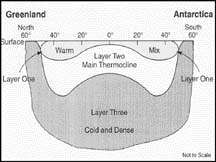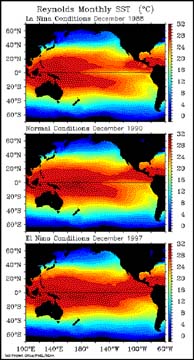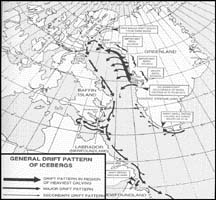B. IMPLICATIONS OF CLIMATE CHANGE
Maritime operations have always been susceptible to the effects of weather. The implications of a warming trend, then, must be examined in order to prepare for future operations. Among the impacts that a warming trend could have on global climate and weather patterns, which in turn could affect maritime operations, are changes to ocean currents, frequency and strength of oceanic storms, winds, frequency of fog, sea-ice distribution and thickness, and sea level rise.2
1. Global Warming
Global climate models predict that global temperatures will continue to rise. The "best estimate" values, as modeled by organizations contributing to the Intergovernmental Panel on Climate Change (IPCC), project an increase of about 2o C by 2100 in global mean surface air temperatures relative to 1990. Refining certain parameters in the model give a range of a 1 to 3.5oC increase, depending on the sensitivity of the climate to atmospheric aerosol composition and concentrations. By 2020, the IS92 model (considered "best estimate") global mean temperature is expected to increase by about 0.4oC. 3
2. Ocean Temperature
Due to the large heat capacity of water, the oceans can absorb a good deal of any atmospheric warming. However, much uncertainty exists relating to the impact of warmer air on complex global and hemispheric oceanic circulation. An important mechanism for distributing temperature extremes on the planet is thermohaline circulation. That is, at the poles, cold, saline water sinks to the bottom of the ocean basin, travels slowly toward the equator, and rises, thus cooling tropical waters. It is a combination of the vertical motion of the thermohaline circulation with wind-driven surface currents, which produces ocean currents.4

Figure I-1. Sea Water Stratification.5
The simulations of the climate model of the National Oceanic and Atmospheric Administration (NOAA) Geophysical Fluid Dynamics Laboratory (GFDL) project that the global thermohaline circulation will decrease in intensity as global warming occurs. This will be due to enhanced precipitation and runoff from the continents in high latitudes. The faster the build-up of CO2, the greater the eventual reduction in the thermohaline circulation and the longer the delay in its recovery.6 Some scientists believe the slowing of this circulation could result in dramatic temperature changes in coastal climates influenced by this circulation, such as Britain, Iceland, and the northeast United States. In addition, it could affect both living marine resources and the formation of mid-latitude storms/hurricanes.
3. Sea Level Rises
Over the past 100 years, global sea levels are estimated to have risen by about 5 to 25 cm, based on analyses of tide gauge records. The IS92 model (considered "best estimate") projects an increase in sea level of about 7 cm by 2020.7 Another recent research effort used the same IPCC model, adding refined forcing indices, and reproduced similar results at year 2020.8 Seawater thermal expansion, which is closely dependent on atmospheric warming, is the most significant cause of rising sea levels. Other factors changing sea levels include mountain glacier retreat and polar ice sheet ablation (erosion by melting) or accumulation.9
Even small increases in sea level can affect low-lying coastal areas and islands. The southern Atlantic and Gulf coasts, which are subsiding (sinking), are highly vulnerable. This is particularly true of southern Florida, where a third of the Everglades has an elevation of less than 12 inches10 (30 cm) above sea level. The Marshall Islands, one of the United States territories in the Pacific, lie almost entirely within three meters of sea level.
Cities close to sea level are being increasingly affected by subsidence due to overuse of groundwater. (High demand on underground aquifers can cause subsidence if aquifers are not allowed sufficient time to refill.) A rise in sea level could severely limit the regions available in densely populated areas for habitation and agriculture.11 Home ports for maritime forces located near these cities would also be affected.
a. Effects on Coastal Ecosystems
This anticipated rise in sea level would place stress upon coastal ecosystems. As a result, river deltas, estuaries, beaches, wetlands, coral reefs, mangrove forests, and sea grass beds may face degradation or eradication as new sea levels affect substrate,12 wave energy and bottom slope.13 This degradation will reduce or limit areas needed by living marine resources to reproduce and feed.

